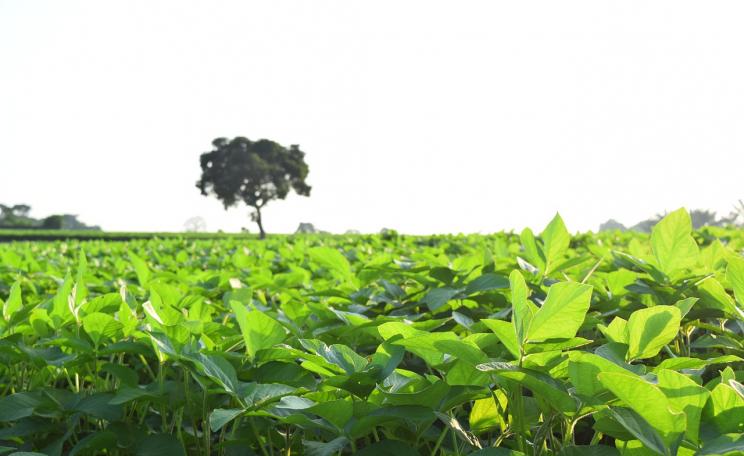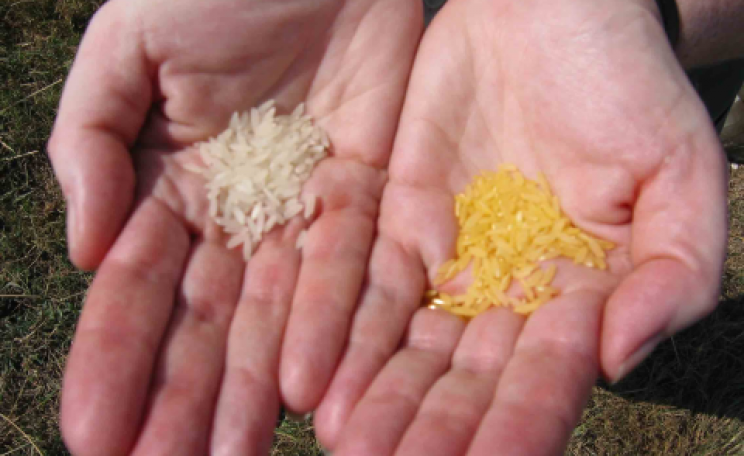Tom Levitt: What is biofortification?
Howarth Bouis: It's basically using plant breeding to develop varieties that have the edible portions that are higher in minerals and vitamins. In order to be successful they have to be just as profitable and high-yielding as existing crops.
TL: Is it just a temporary fix to malnutrition until diets become more diversified?
HB: It's by no means a silver bullet that is going to solve the mineral and vitamin problem. The long run solution is that peoples' incomes go up to the point where they can afford to pay for the diets we all enjoy. Biofortification is something we can do along the way to increase the vitamin uptake. What I like about it is every dollar invested has a very high return. I wouldn’t exactly call it a temporary measure - it’s something which could continue again and again over a long period of time. For example, why wouldn’t people want to eat orange maize? It’s high in vitamin A.
TL: What contribution can it make to malnutrition?
HB: I think it can have a huge impact for deficiencies for specific vitamins and minerals - iron and zinc. Those are considered the main public health concerns at the moment, those and iodine but you can’t really breed for iodine.
TL: What's your view on the controversy surrounding Golden Rice?
HB: First of all, when HarvestPlus started in 2003 we decided that we wanted to invest all of our resources in conventional breeding. Simply because we didn’t want to encounter all the hurdles and the criticisms and the difficulties of the genetically-modified varieties. We consider all of the fear about GM crops unfortunate, but that wasn’t our battle, our battle was to try and improve nutrition and our research showed that we could make improvements in certain crops through conventional breeding. The critics of Golden Rice have done a good job of tainting it. Then when people hear about biofortified crops and HarvestPlus, there’s a presumption that we’re developing transgenic crops. The buzz that goes around HarvestPlus is that it's transgenic but it's actually not. We need to get the word out. I'm actually part of the Golden Rice Humanitarian Board and I think it’s a great idea. I’ve watched all the barriers come up in front of it and slow things down considerably, which is quite unfortunate, but it will be released in the Philippines in 2013, and we look forward to that happening.
TL: Will farmers plant these biofortified crops?
HB: They’re essentially no different than existing crops, the only difference is that there are higher levels of vitamins and nutrients. If they’re hybrid varieties they’ll need to buy the seeds every year. But nothing is fundamentally different. They’ll sell for the same price in the market. Agriculture is risky, so our biofortified crops are just as risky as any normal crops, it’s just that they have this added trait that normal crops don’t have.
TL: What's been the experience of your first pilot project with vitamin A-fortified sweet potato in Uganda?
HB: We disseminated four orange varieties and the farmers could choose which combination of the four varieties they wanted to use. One farmer will like one variety, another farmer will like a second variety. Sometimes they like them to grow a different way above ground or to produce a lot of stems. Or the soil on this farm might be different to the soil on that farm - variety A grows well over here, variety B grows well over here. If you want to satisfy all these different niches of what farmers want, you just need a combination of varieties. My eventual hope is that a child eating orange maize in Africa 20 years from now will be surprised to learn from their parents that there used to be white maize. That would be my ultimate vision, for people to realise that with a relatively small investment in agricultural research you can have these added value traits and pay the same price - it seems a no-brainer.
TL: Who will own the commercial rights to your seeds?
HB: If they’re open-pollinated, nobody really has the right - you grow the cassava, you plant them around, you replant; it’s the same with the rice, same with the wheat, same with the beans. For example, cassava is propagated by growing a cassava and cutting off sections of the stem and then they plant the sections of the stem, so you have to get a few stems to start with, but after that you cut your own stems and replant your own. So you get those stems from maybe buying them from some kind of a dealer who’s selling stems or you can get them from your family or maybe your neighbour. If they're hybrid varieties - they’re owned by the company. What they’ll do is take our [publicly available] parent variety, and develop their own individual hybrids from our parent variety. They’ll own those particular hybrids, but you’ll have several different companies working on varieties, so farmers don’t have to go exclusively to one company. We make our parent varieties available to all companies.
TL: Are you concerned the crops could be sold at a premium and cost poor consumers more?
HB: We don’t want to introduce something where they’re going to have to pay a premium for their basic food staple or more nutritious varieties, because they’re the least able to pay for it. If there’s the same yield, if the price of the other one goes down, farmers will see that they’re less profitable, then they’ll quit growing, they’ll stop doing production of it and the supply will go down, and that will help the price go up. If we have the yields in equilibrium, the prices should be the same. You can have different levels of demand of the two, but the supplies will adjust to equalise the prices. For example, the price of orange sweet potato in the Kampala market in Uganda is selling for more than the white sweet potato. That’s because there’s a certain level of demand for the orange sweet potato. And the supply is relatively small because not that many farmers are growing it. If you’re a farmer growing white sweet potato, and you see that the price for orange sweet potato is higher, you think ‘hey, I’m going to switch over from growing white sweet potato because I can make more of a profit’. And then you’ll have a higher supply, all of a sudden, there’ll be more orange sweet potato available and that’s going to drive the price down.
TL: Does Golden Rice or any other biofortified crop help tackle the root cause of malnutrition?
HB: I think that the long-term solution is having economic growth that the poor share in, and by increasing their incomes, gradually they’ll be able to afford a better quality diet. It’s a long-term thing. That’s very important and that’s the ultimate solution to the problem. I finished graduate school 30 years ago and started working in development - I don’t know that poverty is a less serious problem 30 years later than it was before. Part of the thing is that population’s been growing, we need to continue to invest to increase incomes to these farmers. That’s very important, and I’m sure that billions of dollars are being spent on that, and probably much more should be spent on that. Right now, we’re spending $30 million a year, which is less than a drop in the bucket to develop these crops which should be available on a sustainable basis in the food system and help to alleviate this problem in the mean time.
TL: Is it more cost-effective than giving out supplements?
HB: Five hundred million vitamin A supplements are given out every year, they cost a dollar a supplement, plus a few cents to manufacture, but you have to have a distribution system and people distributing, so there’s a cost to that - we‘ve estimated that it’s a dollar, so that‘s $500 million this year, $500 million next year, over a decade you’ve spent $5 billion. We’re talking about spending $30 million a year to disseminate these varieties - even compared to the cost of vitamin A supplements, it’s a drop in the bucket. Then you have something that’s out there and in the system. Supplements are actually a very good investment, with a very high benefit/cost ratio, but this is something even better.
TL: Will people like the taste of the biofortified crops?
HB: With iron and the zinc, the levels are low - they’re micro-nutrients, so you don’t taste them. The vitamin A is visible - it’s orange. But I don’t think that it really affects the plant.
TL: Why are Syngenta involved (as one of the funders of the project), what do they get out of it?
HB: It’s not the company, it’s Syngenta Foundation. The funding for the foundation comes from the corporation. But the corporation just decided they thought the stuff HarvestPlus were doing was worthwhile, they thought it was a good investment. They want to make a good investment, they want to show people that they’ve spent the money productively. We actually work mostly through NGOs and are just getting started with the dissemination of the orange sweet potato, we distributed the vines to the NGO, paying them to distribute the vines for us and we developed educational materials for them to present to the farmers, to the women, to the wives and to the husbands.
Release dates for biofortified crops by HarvestPlus:
| Sweet Potato | Vitamin A | Uganda, Mozambique | 2007 |
| Cassava | Vitamin A | DR Congo, Nigeria | 2011 |
| Bean | Iron | DR Congo | 2012 |
| Pearl millet | Iron | India | 2012 |
| Maize | Vitamin A | Zambia | 2012 |
| Rice | Zinc | Bangladesh, India | 2013 |
| Wheat | Zinc | India, Pakistan | 2013 |
Howard Bouis is director of HarvestPlus, part of the Centro Internacional de Agricultura Tropical (CIAT) and the International Food Policy Research Institute (IFPRI). It has recieved funding from a number of sources, including DFID and the Bill and Melinda Gates Foundation to develop biofortified crops.
| READ MORE... | |
 |
NEWS Water shortages biggest barrier to increasing food production The real issue in food production is not whether we should go for intensive agriculture, GM crops or organic but future water availability, says an environmental think-tank |
 |
NEWS India bans planting of first GM food crop Campaigners welcome decision to put on hold cultivation of genetically modified (GM) aubergine crop, Bt Brinjal, until 'safety of product' established |
 |
NEWS Revealed: how seed market is controlled by Monsanto, Syngenta, Bayer, Dow & DuPont Graphic illustrates how just five biotech giants have increased their control of the global seed market, promoting monoculture farming and making it harder for farmers to find alternative sources of seeds |
 |
NEWS ANALYSIS Does Kenya need GM crops as it battles famine in the Horn of Africa? In the midst of a dire need to feed millions of people facing hunger because of drought, Kenya's newly passed Biosafety Act allows for the importation of GM crops - but at what cost? |
 |
INVESTIGATION Africa's Green Revolution 2.0: rejecting agribusiness, pesticides and GM greenwash A pioneering campaign is challenging industrial agriculture in Africa, returning food sovereignty to the people and empowering women to lead a new movement that rejects the 'pesticide and loan culture' of the first Green Revolution. Chris Milton reports |








